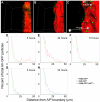Quantitative analysis of Hedgehog gradient formation using an inducible expression system
- PMID: 17484784
- PMCID: PMC1885436
- DOI: 10.1186/1471-213X-7-43
Quantitative analysis of Hedgehog gradient formation using an inducible expression system
Abstract
Background: The Hedgehog (Hh) family of secreted growth factors are morphogens that act in development to direct growth and patterning. Mutations in human Hh and other Hh pathway components have been linked to human diseases. Analysis of Hh distribution during development indicates that cholesterol modification and receptor mediated endocytosis affect the range of Hh signaling and the cellular localization of Hh.
Results: We have used an inducible, cell type-specific expression system to characterize the three-dimensional distribution of newly synthesized, GFP-tagged Hh in the developing Drosophila wing. Following induction of Hh-GFP expression in posterior producing cells, punctate structures containing Hh-GFP were observed in the anterior target cells. The distance of these particles from the expressing cells was quantified to determine the shape of the Hh gradient at different time points following induction. The majority of cholesterol-modified Hh-GFP was found associated with cells near the anterior/posterior (A/P) boundary, which express high levels of Hh target genes. Without cholesterol, the Hh gradient was flatter, with a lower percentage of particles near the source and a greater maximum distance. Inhibition of Dynamin-dependent endocytosis blocked formation of intracellular Hh particles, but did not prevent movement of newly synthesized Hh to the apical or basolateral surfaces of target cells. In the absence of both cholesterol and endocytosis, Hh particles accumulated in the extracellular space. Staining for the Hh receptor Ptc revealed four categories of Hh particles: cytoplasmic with and without Ptc, and cell surface with and without Ptc. Interestingly, mainly cholesterol-modified Hh is detected in the cytoplasmic particles lacking Ptc.
Conclusion: We have developed a system to quantitatively analyze Hh distribution during gradient formation. We directly demonstrate that inhibition of Dynamin-dependent endocytosis is not required for movement of Hh across target cells, indicating that transcytosis is not required for Hh gradient formation. The localization of Hh in these cells suggests that Hh normally moves across both apical and basolateral regions of the target cells. We also conclude that cholesterol modification is required for formation of a specific subset of Hh particles that are both cytoplasmic and not associated with the receptor Ptc.
Figures






Similar articles
-
Patched controls the Hedgehog gradient by endocytosis in a dynamin-dependent manner, but this internalization does not play a major role in signal transduction.Development. 2004 May;131(10):2395-408. doi: 10.1242/dev.01102. Epub 2004 Apr 21. Development. 2004. PMID: 15102702
-
Patched, the receptor of Hedgehog, is a lipoprotein receptor.Proc Natl Acad Sci U S A. 2008 Jan 22;105(3):912-7. doi: 10.1073/pnas.0705603105. Epub 2008 Jan 15. Proc Natl Acad Sci U S A. 2008. PMID: 18198278 Free PMC article.
-
Cellular trafficking of the glypican Dally-like is required for full-strength Hedgehog signaling and wingless transcytosis.Dev Cell. 2008 May;14(5):712-25. doi: 10.1016/j.devcel.2008.03.001. Dev Cell. 2008. PMID: 18477454
-
Hedgehog on the move: a precise spatial control of Hedgehog dispersion shapes the gradient.Curr Opin Genet Dev. 2013 Aug;23(4):363-73. doi: 10.1016/j.gde.2013.04.011. Epub 2013 Jun 5. Curr Opin Genet Dev. 2013. PMID: 23747033 Review.
-
Decoding Ci: from partial degradation to inhibition.Dev Growth Differ. 2015 Feb;57(2):98-108. doi: 10.1111/dgd.12187. Epub 2014 Dec 14. Dev Growth Differ. 2015. PMID: 25495033 Review.
Cited by
-
Mechanisms and functions of Hedgehog signalling across the metazoa.Nat Rev Genet. 2011 Jun;12(6):393-406. doi: 10.1038/nrg2984. Epub 2011 Apr 19. Nat Rev Genet. 2011. PMID: 21502959 Review.
-
A gradient of matrix-bound FGF-2 and perlecan is available to lens epithelial cells.Exp Eye Res. 2014 Mar;120(100):10-4. doi: 10.1016/j.exer.2013.12.004. Epub 2013 Dec 14. Exp Eye Res. 2014. PMID: 24341990 Free PMC article.
-
Absolute requirement of cholesterol binding for Hedgehog gradient formation in Drosophila.Biol Open. 2013 May 9;2(6):596-604. doi: 10.1242/bio.20134952. Print 2013 Jun 15. Biol Open. 2013. PMID: 23789110 Free PMC article.
-
Dynamic interpretation of hedgehog signaling in the Drosophila wing disc.PLoS Biol. 2009 Sep;7(9):e1000202. doi: 10.1371/journal.pbio.1000202. Epub 2009 Sep 29. PLoS Biol. 2009. PMID: 19787036 Free PMC article.
-
The Intimate Connection Between Lipids and Hedgehog Signaling.Front Cell Dev Biol. 2022 Jun 9;10:876815. doi: 10.3389/fcell.2022.876815. eCollection 2022. Front Cell Dev Biol. 2022. PMID: 35757007 Free PMC article. Review.
References
-
- Strigini M, Cohen SM. A Hedgehog activity gradient contributes to AP axial patterning of the Drosophila wing. Development. 1997;124:4697–4705. - PubMed
Publication types
MeSH terms
Substances
Grants and funding
LinkOut - more resources
Full Text Sources
Molecular Biology Databases

